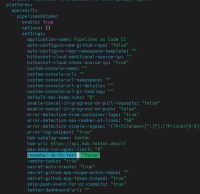-
Story
-
Resolution: Done
-
Undefined
-
None
-
None
-
False
-
-
False
-
With this update, the `remember-ok-to-test` value in Tekton Config is set to `false` by default to reduce the risk of executing untrusted or malicious code in test environments.
-
Enhancement
-
Done
-
-
Story (Required)
As a security-conscious administrator trying to secure the build system, I want the /ok-to-test memory feature to be disabled by default after a migration period, so that external contributors cannot exploit it to push malicious changes targeting the build system, while ensuring a smooth transition for existing installations.
Background (Required)
Currently, when /ok-to-test is remembered, an external contributor can gain trust with a reasonable code change and then push a malicious change aimed at the build system (e.g., secret exfiltration). This poses a significant security risk. To mitigate this, PAC should:
1. Announce a migration period during which /ok-to-test memory will remain enabled by default.
2. After the migration period, disable /ok-to-test memory by default.
3. Provide clear documentation about the risks and require installations to explicitly opt-in to enable this feature, accepting the associated risks.
Out of scope
- Modifying the behavior of /ok-to-test itself.
- Implementing additional security measures beyond disabling the memory feature by default.
Approach (Required)
- Announce a migration period (e.g., 3 months) during which /ok-to-test memory remains enabled by default.
- After the migration period, update PAC to set /ok-to-test memory to false by default.
- Add documentation highlighting the risks of enabling /ok-to-test memory and the migration timeline.
- Allow installations to explicitly enable /ok-to-test memory via configuration.
- Notify existing installations of the upcoming change and provide guidance for migration.
Dependencies
- None identified at this time.
Acceptance Criteria (Mandatory)
- A migration period is announced and documented.
- After the migration period, /ok-to-test memory is disabled by default in PAC.
- Documentation is updated to clearly explain the risks of enabling /ok-to-test memory and the migration process.
- Installations can explicitly enable /ok-to-test memory via configuration.
- Existing installations are notified of the change and provided with migration guidance.
INVEST Checklist
- Dependencies identified: None
- Blockers noted: None
- Design is implementable: Yes
- Acceptance criteria agreed upon: Pending
- Story estimated: Pending
Done Checklist
- Code is completed, reviewed, documented, and checked in.
- Unit and integration test automation delivered and running cleanly.
- Continuous Delivery pipeline(s) can proceed with new code.
- Customer-facing documentation is updated and published.
- Acceptance criteria are met.
